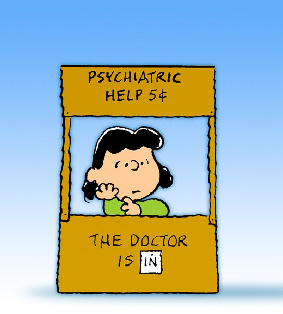 Harriet Hall has an interesting piece about the right to refuse treatment for psychosis over at Science-Based Medicine. The premise of the article is essentially that the right to refuse treatment must be balanced with the potential danger to the public when someone with a sever psychosis is allowed to live in the community. I believe this is true, and I marvel at the modern mental health system where the word of a lawyer and a judge trumps the word of a psychologist or psychiatrist in deciding whether a person is dangerous, yet, as we saw in the Tarasoff case, the mental health practitioner is still responsible for contacting the family of a named potential victim if the legal side of an involuntary commitment hearing falls through.
Harriet Hall has an interesting piece about the right to refuse treatment for psychosis over at Science-Based Medicine. The premise of the article is essentially that the right to refuse treatment must be balanced with the potential danger to the public when someone with a sever psychosis is allowed to live in the community. I believe this is true, and I marvel at the modern mental health system where the word of a lawyer and a judge trumps the word of a psychologist or psychiatrist in deciding whether a person is dangerous, yet, as we saw in the Tarasoff case, the mental health practitioner is still responsible for contacting the family of a named potential victim if the legal side of an involuntary commitment hearing falls through.
So overall I agree with Dr. Hall in that, in some cases, it should be easier to commit someone long term, and we should build long-term treatment facilities. I do, however, have 3 points of contention that I would like to address with Dr. Hall’s post.
Number 1, Hall states that “anosognosia is part of their disease… If you can’t recognize that you are ill, why would you accept treatment for a condition you firmly believe you do not have?” In my experience, and I realize that anecdote is not the singular form of data, but this has been pretty across-the-board, most people with schizophrenia realize that they are ill, but the hallucinations and delusions that they experience are so real that they can’t help believe them. They don’t stop taking medications because they do not believe they are ill, they stop because medication is not perfect and paranoia can set in during brief relapses. Every person with schizophrenia that I have ever worked with has stated that they stopped taking their pills because they thought that the pills were poisoning them. This paranoid delusion also makes people with schizophrenias more resistant to therapy because they believe that the therapist is trying to harm them.
I’m not saying that anosognosia doesn’t play a role, but no client I have ever dealt with has stated that they believe they were not sick. However, most of my clients with schizophrenia have been older and in the system for a while. Perhaps it would be different for someone who is recently diagnosed.
Number 2, Hall at one point leads readers to believe that someone has to have committed a violent act before they can be involuntarily committed, stating “Society will do nothing to help you until he actually hurts someone.” Laws relating to involuntary commitment are different from state to state, and it really boils down to the will of the county mental health commissioner, but in my local system the law clearly states that the individual has to be “a danger to themselves or others.” That doesn’t mean that they have had to attempt a violent act, but they must be a viable threat. I’m not saying that it is easy to have someone committed, but it is not quite as hard as Hall states.
Number 3, Hall seems to forget that the ethos of deinstitutionalization was not just to shut down hospitals, but to put more emphasis on community-based treatment. It is possible to provide a high level of care for people with schizophrenia in a community-based setting. The Title XIX Medicaid Waiver program provides funding for in home care for three distinct groups of people, the MR/DD population, the elderly, and people with severe persistent mental illness. The problem is that most waiver funding goes into the MR/DD sector, with elder care and care for persistent mental illness splitting a very small pot. If we could increase funding for mental illness care, we could provide 24-hour staffing for individuals living with severe and persistent mental illnesses such as schizophrenia.
Of course, maybe one of the problems is one of categorization. We classify MR/DD disorders as Axis II disorders and schizophrenia as an Axis I disorder, despite the fact that both of these disorders appear, if current research is correct, to be fully caused by a person’s genetics and biology. However, the typical age of onset of schizophrenia, late teens to mid twenties in men, early twenties to early thirties in women, leads many to believe that schizophrenia has some sort of social/environmental cause. Mental retardation appears at birth. Schizophrenia takes a while.
Of course, as I type this, a group of doctors are meeting privately to decide the content of the DSM-V. Maybe this insulated group will change things. Then again, maybe not.



 Posted by Danny McCaslin
Posted by Danny McCaslin 





 I love newspapers and news magazines. They are absolutely obsessed with positive psychology. Everything is about making yourself better, faster, stronger, etc. And they always put this stuff in a section called “Living” or “Life.” This brings to mind growth. No one wants to hear the bad stuff,that you will probably die alone, that you’ll never get that promotion. I wonder what kind of person reads this stuff every day.
I love newspapers and news magazines. They are absolutely obsessed with positive psychology. Everything is about making yourself better, faster, stronger, etc. And they always put this stuff in a section called “Living” or “Life.” This brings to mind growth. No one wants to hear the bad stuff,that you will probably die alone, that you’ll never get that promotion. I wonder what kind of person reads this stuff every day. They say that men marry women like their mothers and women marry men like their fathers. In reality, I would say that there are certain featured that both sexes look for and that people who maintain successful relationships seem to have. You think you married a man like your father because a good proportion of the traits you are looking for are actually very attractive to the population as a whole.
They say that men marry women like their mothers and women marry men like their fathers. In reality, I would say that there are certain featured that both sexes look for and that people who maintain successful relationships seem to have. You think you married a man like your father because a good proportion of the traits you are looking for are actually very attractive to the population as a whole.  love and hate about yourself. If you hate some quality of yourself, it will show, and it will look like self-loathing. Your potential mate will be turned off either by the same quality you hate, or your hatred of said quality. Work on yourself first.
love and hate about yourself. If you hate some quality of yourself, it will show, and it will look like self-loathing. Your potential mate will be turned off either by the same quality you hate, or your hatred of said quality. Work on yourself first.